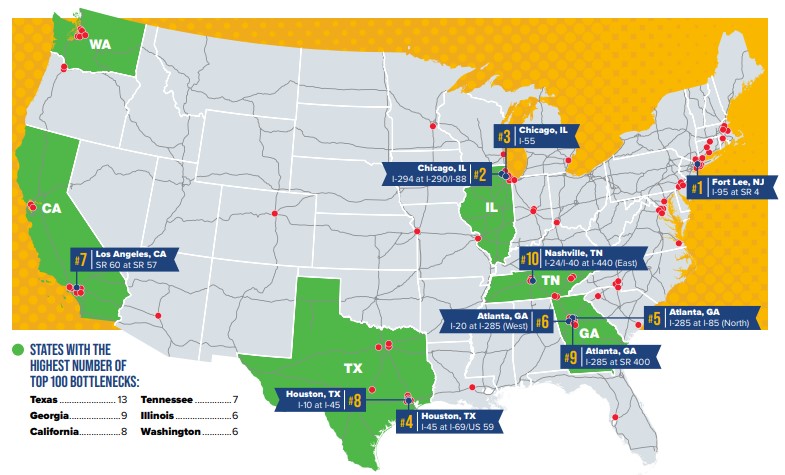New Jersey intersection is top U.S. freight bottleneck for sixth year in a row
For the sixth year in a row, the intersection of I-95 and SR 4 in Fort Lee, New Jersey is once again the Number 1 freight bottleneck in the U.S.
The American Transportation Research Institute (ATRI) has released its 13th annual list highlighting the most congested bottlenecks for trucks in America. The 2024 Top Truck Bottleneck List measures the level of truck-involved congestion at more than 325 locations on the national highway system.
The bottleneck locations detailed in this latest ATRI list represent the top 100 congested locations, although ATRI continuously monitors more than 325 freight-critical locations.

The remaining Top 10 bottlenecks include:
- 2. Chicago: I-294 at I-290/I-88
- 3. Chicago: I-55
- 4. Houston: I-45 at I-69/US 59
- 5. Atlanta: I-285 at I-85 (North)
- 6. Atlanta: I-20 at I-285 (West)
- 7. Los Angeles: SR 60 at SR 57
- 8. Houston: I-10 at I-45
- 9. Atlanta: I-285 at SR 400
- 10. Nashville: I-24/I-40 at I-440 (East)
“Traffic congestion on our National Highway System inflicts an enormous cost on the supply chain and environment, adding $95 billion to the cost of freight transportation and generating 69 million metric tons of excess carbon emissions every year,” said Chris Spear, American Trucking Associations president and CEO.
“The freight bottlenecks identified in this report provide an actionable blueprint for state and federal transportation officials on where to invest infrastructure funding most cost-effectively. Increasing freight efficiency should be a top priority for the U.S. DOT, and alleviating these bottlenecks would improve highway safety, protect the environment and support interstate commerce.”
The analysis, based on an extensive database of freight truck GPS data, uses several customized software applications and analysis methods, along with terabytes of data from trucking operations to produce a congestion impact ranking for each location. ATRI’s truck GPS data is also used to support state and federal freight mobility initiatives.
Have your say
This is a moderated forum. Comments will no longer be published unless they are accompanied by a first and last name and a verifiable email address. (Today's Trucking will not publish or share the email address.) Profane language and content deemed to be libelous, racist, or threatening in nature will not be published under any circumstances.